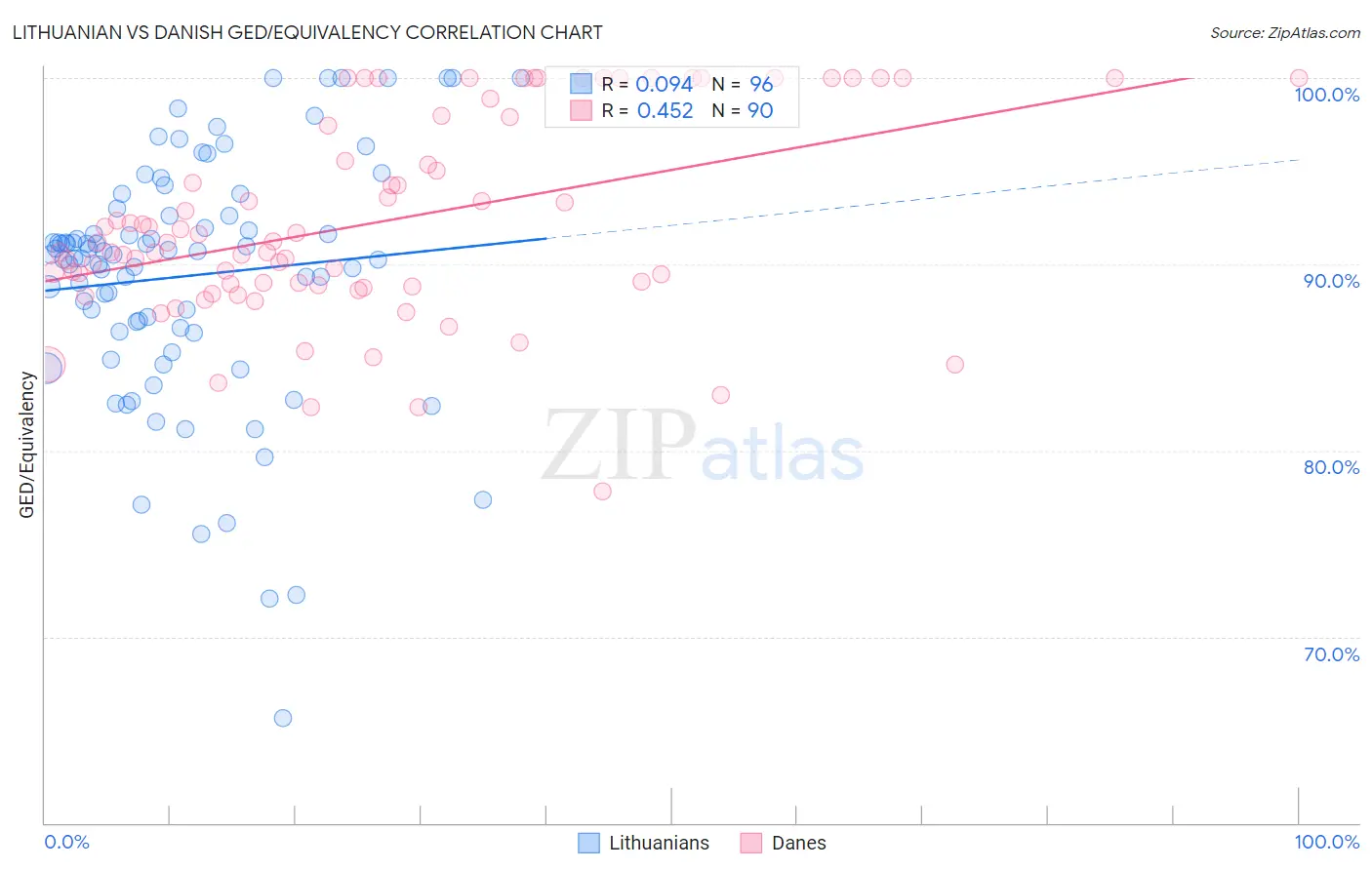Lithuanian vs Danish GED/Equivalency
COMPARE
Lithuanian
Danish
GED/Equivalency
GED/Equivalency Comparison
Lithuanians
Danes
88.9%
GED/EQUIVALENCY
99.9/ 100
METRIC RATING
12th/ 347
METRIC RANK
88.4%
GED/EQUIVALENCY
99.8/ 100
METRIC RATING
32nd/ 347
METRIC RANK
Lithuanian vs Danish GED/Equivalency Correlation Chart
The statistical analysis conducted on geographies consisting of 421,947,832 people shows a slight positive correlation between the proportion of Lithuanians and percentage of population with at least ged/equivalency education in the United States with a correlation coefficient (R) of 0.094 and weighted average of 88.9%. Similarly, the statistical analysis conducted on geographies consisting of 474,193,540 people shows a moderate positive correlation between the proportion of Danes and percentage of population with at least ged/equivalency education in the United States with a correlation coefficient (R) of 0.452 and weighted average of 88.4%, a difference of 0.57%.

GED/Equivalency Correlation Summary
| Measurement | Lithuanian | Danish |
| Minimum | 65.6% | 77.8% |
| Maximum | 100.0% | 100.0% |
| Range | 34.4% | 22.2% |
| Mean | 89.4% | 92.3% |
| Median | 90.5% | 91.2% |
| Interquartile 25% (IQ1) | 86.5% | 88.9% |
| Interquartile 75% (IQ3) | 92.6% | 97.9% |
| Interquartile Range (IQR) | 6.1% | 9.0% |
| Standard Deviation (Sample) | 6.6% | 5.4% |
| Standard Deviation (Population) | 6.5% | 5.3% |
Demographics Similar to Lithuanians and Danes by GED/Equivalency
In terms of ged/equivalency, the demographic groups most similar to Lithuanians are Immigrants from Iran (88.9%, a difference of 0.010%), Cypriot (88.9%, a difference of 0.040%), Okinawan (88.9%, a difference of 0.050%), Immigrants from Taiwan (88.8%, a difference of 0.090%), and Croatian (88.8%, a difference of 0.12%). Similarly, the demographic groups most similar to Danes are Bhutanese (88.4%, a difference of 0.020%), Turkish (88.5%, a difference of 0.050%), Polish (88.5%, a difference of 0.070%), Immigrants from Northern Europe (88.5%, a difference of 0.10%), and Immigrants from Lithuania (88.6%, a difference of 0.14%).
| Demographics | Rating | Rank | GED/Equivalency |
| Lithuanians | 99.9 /100 | #12 | Exceptional 88.9% |
| Immigrants | Iran | 99.9 /100 | #13 | Exceptional 88.9% |
| Cypriots | 99.9 /100 | #14 | Exceptional 88.9% |
| Okinawans | 99.9 /100 | #15 | Exceptional 88.9% |
| Immigrants | Taiwan | 99.9 /100 | #16 | Exceptional 88.8% |
| Croatians | 99.9 /100 | #17 | Exceptional 88.8% |
| Slovenes | 99.9 /100 | #18 | Exceptional 88.8% |
| Swedes | 99.9 /100 | #19 | Exceptional 88.8% |
| Maltese | 99.9 /100 | #20 | Exceptional 88.6% |
| Luxembourgers | 99.8 /100 | #21 | Exceptional 88.6% |
| Immigrants | Ireland | 99.8 /100 | #22 | Exceptional 88.6% |
| Russians | 99.8 /100 | #23 | Exceptional 88.6% |
| Slovaks | 99.8 /100 | #24 | Exceptional 88.6% |
| Estonians | 99.8 /100 | #25 | Exceptional 88.6% |
| Immigrants | Australia | 99.8 /100 | #26 | Exceptional 88.6% |
| Immigrants | Lithuania | 99.8 /100 | #27 | Exceptional 88.6% |
| Immigrants | Northern Europe | 99.8 /100 | #28 | Exceptional 88.5% |
| Poles | 99.8 /100 | #29 | Exceptional 88.5% |
| Turks | 99.8 /100 | #30 | Exceptional 88.5% |
| Bhutanese | 99.8 /100 | #31 | Exceptional 88.4% |
| Danes | 99.8 /100 | #32 | Exceptional 88.4% |